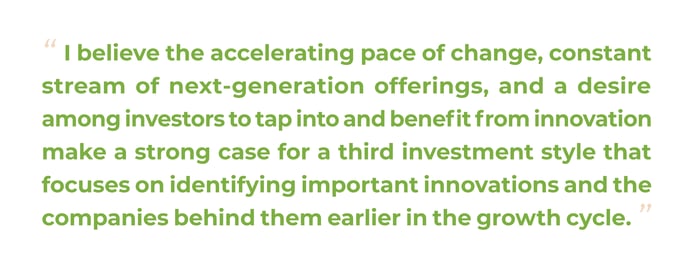Does the rise of innovation investing warrant a new investment style? Evolutionary Tree President and CIO Thomas Ricketts believes it does. In a recent “Behind the Markets” podcast hosted by Jeremy Schwartz, Mr. Ricketts offered his perspective on how investors seeking to fully participate in the rise of innovation are finding it necessary to look beyond traditional growth investing. A few of the key points Mr. Ricketts made in favor of innovation investing as the third investing style follow.
Mr. Ricketts: To understand how innovation investing differs from traditional growth investing, it may be helpful to provide some history and context.
The traditional growth and value investing styles were developed during the early and mid-part of the 20th century, with value initially becoming the dominant style in the 1920s and 1930s. After World War II, the emergence of large-brand growth companies drove greater interest and participation in growth style investing.
Today, however, the economy is profoundly different than that era. We’re living in the digital age—what I refer to as the innovation economy—and it has become increasingly apparent that investment styles developed nearly a century ago may no longer fully meet investors’ needs.
Innovative businesses are very different in their economics from more traditional businesses, so the two dominant styles—value and growth—are, in my opinion, getting stale.
I believe the accelerating pace of change, constant stream of next-generation offerings, and a desire among investors to tap into and benefit from innovation make a strong case for a third investment style that focuses on identifying important innovations and the companies behind them earlier in the growth cycle.

While many innovation-type businesses are classified as “growth,” I believe the traditional growth style of investing is not optimally positioned to benefit from the innovation economy. Consider, for example, that a key metric many growth managers look for in companies is above-average growth over the past five to ten years. From an innovation investor’s perspective, waiting five years or longer is too late in the value-creation process. Given the rapid pace at which new products and innovations are being launched and adopted, we seek to identify and invest in leading innovators earlier in their growth cycle. That’s an important differentiator between growth and innovation investing.
Rather than chase an outcome—and growth is just an outcome—innovation investors believe it’s much more important to look for the source of future growth, rather than historical growth trends, and invest early. It’s important to remember that investors only get paid on future growth, not past growth. By searching for important innovations and the quality innovators developing them, innovation investors can potentially get ahead of the traditional growth and value investors. That is what we aim to do at Evolutionary Tree, and we believe this is the optimal way to add value for clients over the long term.
For additional insight from Mr. Ricketts on a range of topics, you can listen to the “Behind the Markets” podcast here. Mr. Ricketts is the featured speaker and immediately follows the short interview with Jeremy Siegel; his interview begins at minute 9:30.

